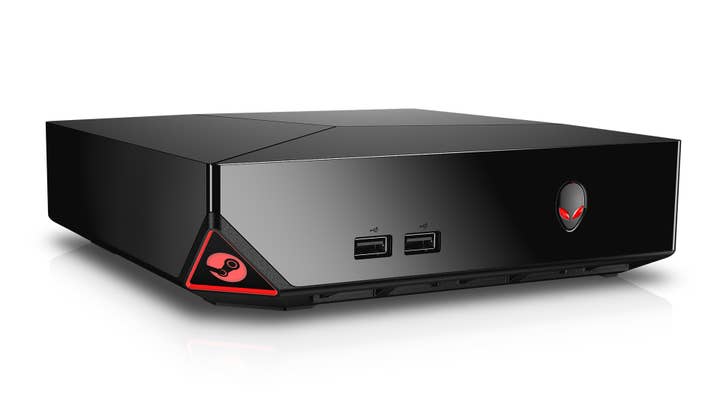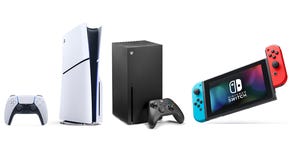Valve's VR thrills, but Steam Machines are looking like a flop
Putting PC innards into smaller boxes is nothing new; if Steam Machines are to fulfil their purpose, they need to lower the bar to entry to PC gaming
There's not a lot to argue with the consensus view that Valve had the biggest and most exciting announcement of GDC this year, in the form of the Vive VR headset it's producing with hardware partner HTC. It may not be the ultimate "winner" of the battle between VR technologies, but it's done more than most to push the whole field forwards - and it clearly sparked the imaginations of both developers and media in San Francisco earlier this month. Few of those who attended GDC seem particularly keen to talk about anything other than Vive.
From Valve's perspective, that might be just as well - the incredibly strong buzz around Vive meant that it eclipsed Valve's other hardware-related announcement at GDC, the unveiling of new details of the Steam Machines initiative. Ordinarily, it might be an annoying (albeit very high-quality) problem to have one of your announcements completely dampen enthusiasm for the other; in this instance, it's probably welcome, because what trickled out of GDC regarding Steam Machines is making this look like a very stunted, unloved and disappointing project indeed.
To recap briefly; Steam Machines is Valve's attempt to create a range of attractive, small-form-factor PC hardware from top manufacturers carrying Valve's seal of approval (hence being called "Steam Machines" and quite distinctly not "PCs"), running Valve's own gaming-friendly flavour of the Linux OS, set up to connect to your living room TV and controlled with Valve's custom joypad device. From a consumer standpoint, they're Steam consoles; a way to access the enormous library of Steam content (at least the Linux-friendly parts of it) through a device that's easy to buy, set up and control, and designed from the ground up for the living room.
"Valve isn't building the machines itself, but since it's putting its seal of approval on them...it ought to have the power to enforce various standards related to specification and performance"
That's a really great idea, but one which requires careful execution. Most of all, if it's going to work, it needs a fairly careful degree of control; Valve isn't building the machines itself, but since it's putting its seal of approval on them (allowing them to use the Steam trademark and promoting them through the Steam service), it ought to have the power to enforce various standards related to specification and performance, ensuring that buyers of Steam Machines get a clear, simple, transparent way to understand the calibre of machine they're purchasing and the gaming performance they can expect as a result.
Since the announcement of the Steam Machines initiative, various ways of implementing this have been imagined; perhaps a numeric score assigned to each Machine allowing buyers to easily understand the price to performance ratio on offer? Perhaps a few distinct "levels" of Steam Machine, with some wiggle room for manufacturers to distinguish themselves, but essentially giving buyers a "Good - Better - Best" set of options that can be followed easily? Any such rating system could be tied in to the Steam store itself, so you could easily cross-reference and find out which system is most appropriate for the kind of games you actually want to play.
In the final analysis, it would appear that Valve's decision on the myriad possibilities available to it in this regard is the worst possible cop-out, from a consumer standpoint; the company's decided to do absolutely none of them. The Steam Machines page launched on the Steam website during GDC lists 15 manufacturers building the boxes; many of those manufacturers are offering three models or more at different price and performance levels. There is absolutely no way to compare or even understand performance across the different Steam Machines on offer, short of cross-referencing the graphics cards, processors, memory types and capacities and drive types and capacities used in each one - and if you've got the up-to-date technical knowledge to accurately balance those specifications across a few dozen different machines and figure out which one is the best, then you're quite blatantly going to be the sort of person who saves money by buying the components separately and wouldn't buy a Steam Machine in a lifetime.
"Valve seems to have copped out entirely from the idea of using its new systems to make the process of buying a gaming PC easier or more welcoming for consumers"
In short, unless there's a pretty big rabbit that's going to be pulled out of a hat between now and the launch of the first Steam Machines in the autumn, Valve seems to have copped out entirely from the idea of using its new systems to make the process of buying a gaming PC easier or more welcoming for consumers - and in the process, appears to have removed pretty much the entire raison d'etre of Steam Machines. The opportunity for the PC market to be grown significantly by becoming more "console-like" isn't to do with shoving PC components into smaller boxes; that's been happening for years, occasionally with pretty impressive results. Nor is it necessarily about reducing the price, which has also been happening for some years (and which was never going to happen with Steam Machines anyway, as Valve is of no mind to step in and become a loss-leading platform holder).
Rather, it's about lowering the bar to entry, which remains dizzyingly high for PC gaming - not financially, but in knowledge terms. A combination of relatively high-end technical knowledge and of deliberate and cynical marketing-led obfuscation of technical terminology and product numbering has meant that the actual process of figuring out what you need to buy in order to play the games you want at a degree of quality that's acceptable is no mean feat for an outsider wanting to engage (or re-engage) with PC games; it's in this area, the simplicity and confidence of buying a system that you know will play all the games marketed for it, that consoles have an enormous advantage over the daunting task of becoming a PC gamer.
Lacking any guarantee of performance or simple way of understanding what sort of system you're buying, the Steam Machines as they stand don't do anything to make that process easier. Personally, I ought to be slap bang in the middle of the market for a Steam Machine; I'm a lapsed PC gamer with a decent disposable income who is really keen to engage with some of the games coming out in the coming year (especially some of the Kickstarted titles which hark back to RPGs I used to absolutely adore), but I'm totally out of touch with what the various specifications and numbers mean. A Steam Machine that I could buy with the confidence that it would play the games I want at decent quality would be a really easy purchase to justify; yet after an hour flicking over and back between the Steam Machines page launched during GDC and various tech websites (most of which assume a baseline of knowledge which, in my case, is a good seven or eight years out of date), I am no closer to understanding which machine I would need or what kind of price point is likely to be right for me. Balls to it; browser window full of tabs looking at tech spec mumbo-jumbo closed, PS4 booted up. Sale lost.
"Suddenly, the question of PC specifications has become even more important than before, because PCs incapable of delivering content of sufficient quality simply won't work for VR"
This would be merely a disappointment - a missed opportunity to lower the fence and let a lot more people enjoy PC gaming - were it not for the extra frisson of difficulty posed by none other than Valve's more successful GDC announcement, the Vive VR headset. You see, one of the things that's coming across really clearly from all the VR technology arriving on the market is that frame-rate - silky-smooth frame-rate, at least 60FPS and preferably more if the tech can manage it - is utterly vital to the VR experience, making the difference between a nauseating, headache-inducing mess and a Holodeck wet dream. Suddenly, the question of PC specifications has become even more important than before, because PCs incapable of delivering content of sufficient quality simply won't work for VR. One of the appealing things about a Steam Machine ought to be the guarantee that I'll be able to plug in a Vive headset and enjoy Valve's VR, if not this year then at some point down the line; yet lacking any kind of certification that says "yes, this machine is going to be A-OK for VR experiences for now", the risk of an expensive screw-up in the choice of machine to buy seems greater than ever before.
I may be giving Steam Machines a hard time unfairly; it may be that Valve is actually going to slap the manufacturers into line and impose a clear, transparent way of measuring and certifying performance on the devices, giving consumers confidence in their purchases and lowering the bar to entry to PC gaming. I hope so; this is something that only Valve is in a position to accomplish and that is more important than ever with VR on the horizon and approaching fast. The lack of any such system in the details announced thus far is bitterly disappointing, though. Without it, Steam Machines are nothing more than a handful of small form-factor PCs running a slightly off-kilter OS; of no interest to hobbyists, inaccessible to anyone else, and completely lacking a compelling reason to exist.









